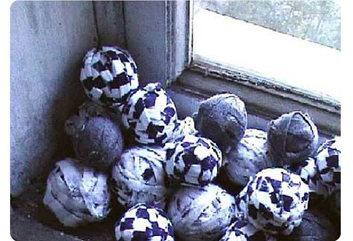
Site Specific Art
[intro] [ch1] [ch2] [ch3] [ch4] [ch5] [ch6] [end] [home]
Françoise Dupré
Introduction
Underpinning my practice is my concern with the nature of the creative process
and the condition of art production. My current work investigates the hand-made
and the everyday and aims to celebrate home craft and the invisible and marginal
art of making and creating in the everyday. I make objects, site-specific and
context-based installations and temporary events. I work in many different kind
of spaces in the studio and the gallery and in non-art spaces. With a wide range
of projects in the UK and abroad, I am developing a model of practice that is
dialogue-based and investigate ways of making art that come through the process
of social interaction with places and creative collaboration with people and
communities.
As a practising artist my experience of work in sites of learning is huge and diverse. Since the 70s I have contributed and led a wide range of art and education projects, schemes and courses. I have worked with a wide range of people and communities within and outside formal educational frameworks . First this was done simply to make a living then to subsidise my art practice. Today, he school, the gallery, the factory, the community centre are sites that are equally relevant to my practice. These sites are inhabited by different kinds of communities and what interests me is to create interaction with and between these communities, make art that shows the flow that exists between these locations and prod at the fences and prejudices that still separate them. I work with young people because it is a group with whom I feel confident and happy to work. Working creatively with young people in or outside school allows me to gain a special insight into a local community, this experience is extremely valuable when making work in response to a place. My work in school is education-based, after all this is the specificity of the site. The activities that I initiate and develop take place within an education framework. However it is a creative partnership which aims to bring to the school a creative experience that does not necessarily fits within pedagogic parameters.

I choose projects that are highly demanding and require a huge amount of commitment. These projects are long term, collaborative and nomadic and raise many issues: managerial, logistic, funding, sustainability, authorship, labelling.... These are challenging contexts for practitioners, participants, cultural and academic institutions, critics, and funding agencies.
One project that has been instrumental in the development of my practice is emplacements, an ongoing artist led international context specific project. For With emplacements I have been able to develop a practice which operates in between cultural and social zones, a position that allows interaction with and between existing and recognised art institutions, and non-art spaces and communities. I do not consider this position as marginal but part of a rich family of socially engaged practices.
Emplacements
Background
emplacements is an on-going, artist led and cross-cultural collaborative project
created in 1997 by Roxane Permar and myself in response to our desire to initiate
and realise context-specific events and develop and nurture multi-layered dialogues
between artists, places and audiences. The fluidity of the project as a series
of temporary events, reflects our concerns with processes rather than with finality.
Our first two events: disEMplacements and relocation took place in 1999 in London. In 2000 we organised our first event in St Petersburg in the historic site of New Holland. Following the success of New Holland and the development of strong links between UK and St Petersburg participating artists it was decided to continue working in St Petersburg and discussions around a major public event, to coincide with the city 300th anniversary in 2003, began. In 2001, Gail Pearce joined us to constitute the UK core team. A series of short visits to St Petersburg in 2001 and early 2002 strengthened existing partnerships and allow new ones to be formed. Through the years, the emplacements team has sought, developed and nourished on going and long term dialogues and partnerships with UK and Russian institutions, individuals, artists and curators. The project’ structure continues to evolve and is unique because it is adapted to the cultural and economic context of St Petersburg and engages with cultural differences. It has been a long and sometime difficult and frustrating but nevertheless rewarding process.
The Red Banner Knitwear Factory
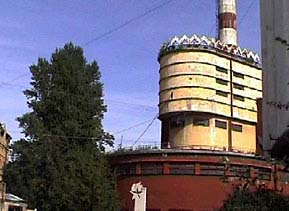
In 2002 emplacements returned to the city to realise its second event at the Red Banner Knitwear Factory, a working textile factory on Petrograd Island. From the 1st August 2002 and for three weeks, 20 artists from UK, Germany, France and Russia had access to various part of the factory and were introduced to the factory stages of production and archives. A disused floor, in the factory’s 19th century building, was made available for the artists to use as studio and meeting place Artists, individually or collaboratively, developed work in response to their experience of the factory, its history, environment, the people who work there, and its architectural significance, in particular the part of the factory, including its power station, designed by the architect, Erich Mendelsohn. A two day public event gave visitors and workers the opportunity to view work realised during the three weeks. It included installations of sculpture, video, sound, mixed media and photography.
Emplacements events New Holland and Red Banner Knitwear Factory have raised issues integral to the city’s contemporary context of urban regeneration, labour history and current debates around the protection of historical industrial buildings. In St Petersburg the project received wide television, radio and newspaper coverage in which these issues were highlighted.
At the Red Banner Knitwear Factory, I realised two temporary works: petrograd and gvozdika, and began work on the project Tell me where you live.
At the Red Banner Knitwear Factory, I realised two temporary works petrograd and gvozdika. These were not planned in advance but were made in direct response to the factory, its history and its people. petrograd was a site specific installation consisting of a series of small textile balls made with offcuts from factory knitwear and placed in one of the windows of the atelier. Participating artists and children of factory workers contributed to the piece. The installation evoked the ways in which the windows had been insulated with offcuts by the factory workers. By using offcuts I wanted to highlight the ways in which workers have been, even in Soviet Russia, discarded at the bottom of the industrial, economic and social ladder I also learnt that the factory offcuts were used and recycled to make rugs and it felt right to use the offcuts as material. The balls were ‘trapped’ between the outside world and the atelier that was an empty silent space with large oil stains and dangling electric cables. petrograd was a melancholic piece which evoked my sadness in seeing the factory in semi dereliction and under threat of closure.
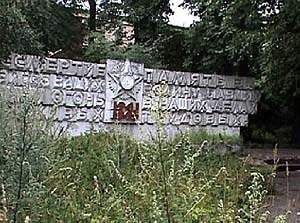
Gvozdika (carnations) was a temporary event. On the first public event day, to honour the factory workers who had died during the second world war, I placed a bouquet of red carnations on the Factory War Memorial located in the factory’s garden next to the power station. All were in a great state of neglect. Following advise from Russian friends I chose red carnations because they are traditionally used for memorials, and red is the colour of victory and celebration.
Tell me where you live was a fragmented project with diverse geographical, cultural and social contexts: St Petersburg, Birmingham, school, textile factory, contemporary art gallery and State Museum. The contextual diversity and the complexity of interfacing with institutions and communities - each with their own cultural value system and understanding of creativity- made the project challenging. Indeed today, these are challenges that I have made part of my practice and consider means of engagements and dissent as I aim to develop a practice that transgresses the fixity of cultural and social boundaries.
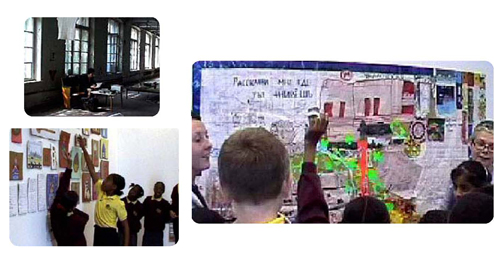
Tell me where you live was realised in collaboration with young people and consisted of a series of artwork made in two stages and in two locations. First in St Petersburg at the Red Banner Knitwear Factory in August 2002 then in Birmingham at the Woodview Primary School and the Ikon Gallery in September 2002. The theme of the project was the city of St Petersburg and engaged with the concepts of place and journey with the aim to facilitate cross-cultural experience.
Challenge and dissent
For me, making work that engages with a site, its history, people and location can only be done through the process of social interaction and creative collaboration with people and communities. This is why for my work at the Red Banner Knitwear Factory I chose to initiate and develop work with a group of local young people. Tell me where you live gave me the opportunity to engage with a locality and a community in a way that I would not have been able to do if I had not developed a dialogue with this group of children. My understanding and experience of the factory and its locality became very special indeed and informed my other two work petrograd and gvozdika.
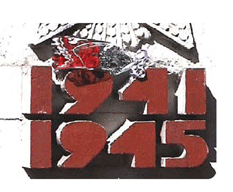
In my introduction I stated that the work I create in a school, a factory and a gallery, are, in equal measure, part of my practice and that working simultaneously in these different places is about creating dialogues with and between these communities. However we all know that art projects associated with education and children are given a low status by most contemporary art and academic institutions. My practice is a messy, unfixed and transient process and I believe that there are many locations where art making can take place and this include sites of learning. Unfortunately this is a context that is irrelevant to mainstream contemporary Fine Art practice. However, Tell me where you live could not be marginalised because it was part of the broader and bigger context that is emplacements and this allows the project to flourish and transcend the prejudices attached to education-based projects. I believe this was also possible because of the nomadic and transient nature of Tell me where you live. The project did not belong to one field of activity but evolved in and out and between different cultural and social sites.
emplacements has been very important for my practice because it has helped me to conceptualise and develop strategies which allow my practice to transgress the categories of art production and challenge the existing and fixed institutional structures. The challenge here is not one of confrontation but of infiltration and interconnection.
Today, I am developing a decentering practice of interconnectivity that aims to break the boundaries between ‘high’ and ‘low’ culture through the development and realisation of long term, nomadic and independent projects My forthcoming project de fil en aiguille.... continues what I began with emplacements: that is, to create and develop a creative context with interconnected sites of practice, a context where a practice in sites of learning is considered as an integral part of the creative process.
©2004 Françoise Dupré
Project B on AXIS ONLINE